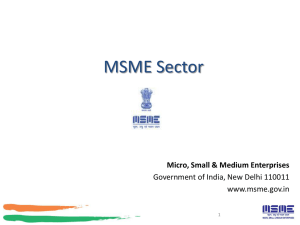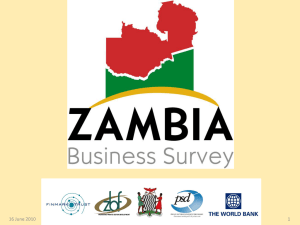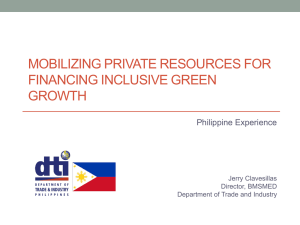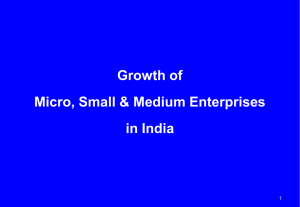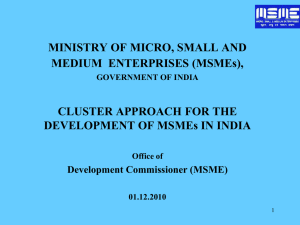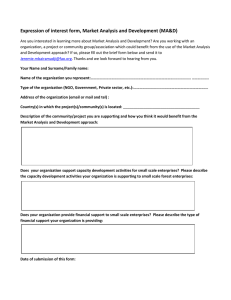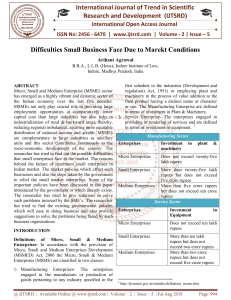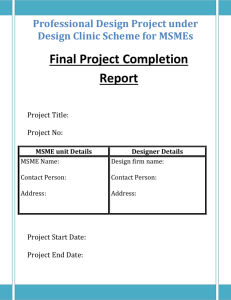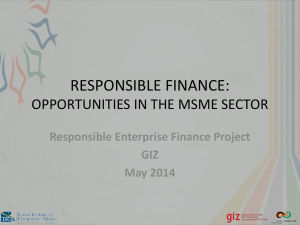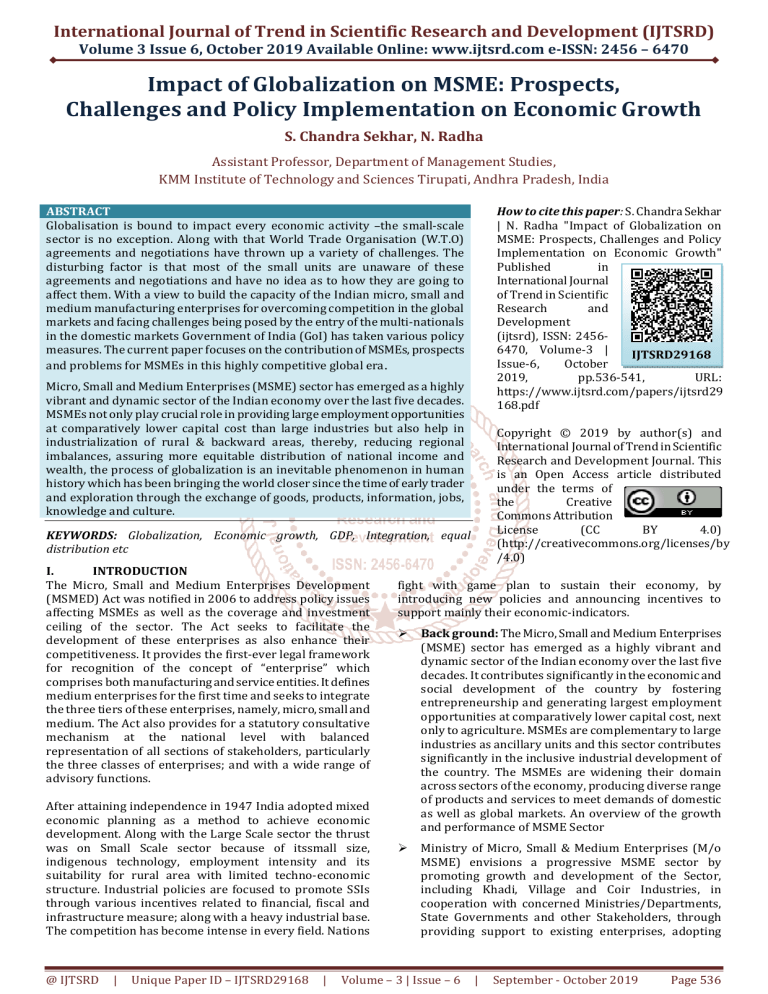
International Journal of Trend in Scientific Research and Development (IJTSRD)
Volume 3 Issue 6, October 2019 Available Online: www.ijtsrd.com e-ISSN: 2456 – 6470
Impact of Globalization on MSME: Prospects,
Challenges and Policy Implementation on Economic Growth
S. Chandra Sekhar, N. Radha
Assistant Professor, Department of Management Studies,
KMM Institute of Technology and Sciences Tirupati, Andhra Pradesh, India
How to cite this paper: S. Chandra Sekhar
| N. Radha "Impact of Globalization on
MSME: Prospects, Challenges and Policy
Implementation on Economic Growth"
Published
in
International Journal
of Trend in Scientific
Research
and
Development
(ijtsrd), ISSN: 24566470, Volume-3 |
IJTSRD29168
Issue-6,
October
2019,
pp.536-541,
URL:
https://www.ijtsrd.com/papers/ijtsrd29
168.pdf
ABSTRACT
Globalisation is bound to impact every economic activity –the small-scale
sector is no exception. Along with that World Trade Organisation (W.T.O)
agreements and negotiations have thrown up a variety of challenges. The
disturbing factor is that most of the small units are unaware of these
agreements and negotiations and have no idea as to how they are going to
affect them. With a view to build the capacity of the Indian micro, small and
medium manufacturing enterprises for overcoming competition in the global
markets and facing challenges being posed by the entry of the multi-nationals
in the domestic markets Government of India (GoI) has taken various policy
measures. The current paper focuses on the contribution of MSMEs, prospects
and problems for MSMEs in this highly competitive global era.
Micro, Small and Medium Enterprises (MSME) sector has emerged as a highly
vibrant and dynamic sector of the Indian economy over the last five decades.
MSMEs not only play crucial role in providing large employment opportunities
at comparatively lower capital cost than large industries but also help in
industrialization of rural & backward areas, thereby, reducing regional
imbalances, assuring more equitable distribution of national income and
wealth, the process of globalization is an inevitable phenomenon in human
history which has been bringing the world closer since the time of early trader
and exploration through the exchange of goods, products, information, jobs,
knowledge and culture.
Copyright © 2019 by author(s) and
International Journal of Trend in Scientific
Research and Development Journal. This
is an Open Access article distributed
under the terms of
the
Creative
Commons Attribution
License
(CC
BY
4.0)
(http://creativecommons.org/licenses/by
/4.0)
KEYWORDS: Globalization, Economic growth, GDP, Integration, equal
distribution etc
I.
INTRODUCTION
The Micro, Small and Medium Enterprises Development
(MSMED) Act was notified in 2006 to address policy issues
affecting MSMEs as well as the coverage and investment
ceiling of the sector. The Act seeks to facilitate the
development of these enterprises as also enhance their
competitiveness. It provides the first-ever legal framework
for recognition of the concept of “enterprise” which
comprises both manufacturing and service entities. It defines
medium enterprises for the first time and seeks to integrate
the three tiers of these enterprises, namely, micro, small and
medium. The Act also provides for a statutory consultative
mechanism at the national level with balanced
representation of all sections of stakeholders, particularly
the three classes of enterprises; and with a wide range of
advisory functions.
After attaining independence in 1947 India adopted mixed
economic planning as a method to achieve economic
development. Along with the Large Scale sector the thrust
was on Small Scale sector because of itssmall size,
indigenous technology, employment intensity and its
suitability for rural area with limited techno-economic
structure. Industrial policies are focused to promote SSIs
through various incentives related to financial, fiscal and
infrastructure measure; along with a heavy industrial base.
The competition has become intense in every field. Nations
@ IJTSRD
|
Unique Paper ID – IJTSRD29168
|
fight with game plan to sustain their economy, by
introducing new policies and announcing incentives to
support mainly their economic-indicators.
Back ground: The Micro, Small and Medium Enterprises
(MSME) sector has emerged as a highly vibrant and
dynamic sector of the Indian economy over the last five
decades. It contributes significantly in the economic and
social development of the country by fostering
entrepreneurship and generating largest employment
opportunities at comparatively lower capital cost, next
only to agriculture. MSMEs are complementary to large
industries as ancillary units and this sector contributes
significantly in the inclusive industrial development of
the country. The MSMEs are widening their domain
across sectors of the economy, producing diverse range
of products and services to meet demands of domestic
as well as global markets. An overview of the growth
and performance of MSME Sector
Ministry of Micro, Small & Medium Enterprises (M/o
MSME) envisions a progressive MSME sector by
promoting growth and development of the Sector,
including Khadi, Village and Coir Industries, in
cooperation with concerned Ministries/Departments,
State Governments and other Stakeholders, through
providing support to existing enterprises, adopting
Volume – 3 | Issue – 6
|
September - October 2019
Page 536
International Journal of Trend in Scientific Research and Development (IJTSRD) @ www.ijtsrd.com eISSN: 2456-6470
cutting edge technologies and encouraging creation of
new enterprises
A number of statutory and non-statutory bodies work
under the aegis of the Ministry of MSME. These include
the Khadi Village Industries Commission (KVIC) and the
Coir Board besides National Small Industries
Corporation (NSIC), National Institute for Micro, Small
and Medium Enterprises (NIMSME) and Mahatma
Gandhi Institute for Rural Industrialisation (MGIRI).
the Ministry of MSME runs various schemes aimed at
financial assistance, technology assistance and up
gradation,
infrastructure
development,
skill
development and training, enhancing competitiveness
and market assistance of MSMEs
Establishment of a National Board for Micro Small and
Medium Enterprises headed by the Minister for MSME.
The role of the Board is to examine the factors affecting
the promotion and development of MSMEs, review the
policies and programmes of the Central Government and
make recommendations in regard to facilitating the
promotion and development and enhancing their
competitiveness.
It provides the first-ever legal framework for
recognition of the concept of “enterprise” which
comprises both manufacturing and service entities. It
defines medium enterprises for the first time and seeks
to integrate the three tiers of these enterprises, namely,
micro, small and medium
It empowers the Central Government to undertake
programmes and issue guidelines and instructions to
Mandate of the Ministry of MSME:
develop and enhance the competitiveness of MSMEs
The Micro, Small and Medium Enterprises Development
(MSMED) Act was notified in 2006 to address different
Definition: In accordance with the provision of Micro, Small
issues affecting MSMEs inter-alia the coverage and
& Medium Enterprises Development (MSMED) Act, 2006 the
investment ceiling of the sector. The MSMED Act seeks to
Micro, Small and Medium Enterprises (MSME) are classified
facilitate the development of these enterprises as also
as below:
enhance their competitiveness. The MSMED Act has the
following key provisions:
Manufacturing Sector
Enterprise Category
Investment in plant & machinery
Micro Enterprises
Does not exceed twenty five lakh rupees
Small Enterprises
More than twenty five lakh rupees but does not exceed five core rupees
Medium Enterprises
More than five core rupees but does not exceed ten core rupees
Enterprise Category
Micro Enterprises
Small Enterprises
Medium Enterprises
Service Sector
Investment in equipment
Does not exceed ten lakh rupees
More than ten lakh rupees but does not exceed two core rupees
More than two core rupees but does not exceed five core rupees
The primary responsibility of promotion and development of MSMEs is of the State Governments. However, the Government of
India, supplements efforts of the State Governments through various initiatives. The role of the Ministry of MSME and its
organisations is to assist the States in their efforts to encourage entrepreneurship, employment and livelihood opportunities
and enhance the competitiveness of MSMEs in the changed economic scenario
1. Registered Sector: Enterprises registered with District Industries Centres in the State/UTs., KVIC/ Khadi and Village
Industries Board, Coir Board as on 31.03.2007 and factories under the coverage of section 2m(i) and 2m(ii) of the Factories
Act 1948 used for Annual Survey of Industry having investment in plant and machinery upto Rs 10 core were considered to
belong to registered sector.
2. Unregistered Sector: All enterprises engaged in the activities of manufacturing or in providing/rendering of services, not
registered permanently or not filed EM with State Directorates of Industries/District Industries Centres on or before 31-32007 are called unregistered enterprises.
3. Small Scale Industrial Unit: An industrial undertaking in which the investment in fixed assets in plant & machinery,
whether held on ownership terms, or on lease, or by hire purchase, does not exceed Rs. 100 lakhs as on 31-03-2001 is to be
treated as a Small Scale Industrial Unit.(iv) Micro Small Medium Enterprises (MSME): MSME Sector consists of any
enterprises, whether proprietorship, Hindu undivided family, association of persons, co-operative society, partnership or
undertaking or any other legal entity, by whatever name called, engaged in production of goods pertaining to any industry
specified in the first schedule of Industries Development and Regulation Act, 1951 & other enterprises engaged in
production and rendering services, subject to limiting factor of investment in plant and machinery and equipment
respectively as noted below:
A. Micro enterprise, if investment in plant and machinery does not exceed twenty five lakh rupees;
B. Small enterprise, if investment in plant and machinery is more than twenty five lakh rupees but does not exceed five
core rupees;
C.
Medium enterprise, if investment in plant and machinery is more than five core rupees but does not exceed ten core
rupees
@ IJTSRD
|
Unique Paper ID – IJTSRD29168
|
Volume – 3 | Issue – 6
|
September - October 2019
Page 537
International Journal of Trend in Scientific Research and Development (IJTSRD) @ www.ijtsrd.com eISSN: 2456-6470
RECENT POLICY INITIATIVE:
Ease of Registration Process of MSMEs- Udyog Aadhaar Memorandum
Based on the Hon’ble Prime Minister’s suggestion in his ‘Mann Ki Baat’ on 3.10.2014, to simplify forms to enable ease of
registration of MSME’s, Ministry of MSME has notified a simple one-page registration form ‘Udyog Aadhaar Memorandum’
(UAM) on 18th September 2015. The simplified one-page registration form UAM was made after consultations with the
states and stakeholders, on the basis of recommendations made by the Kamath Committee on Financial Architecture and
observations/approvals by Department Related Parliamentary Standing Committee, National Board for MSME and
Advisory Committee for MSMEetc.
This is a path breaking step to promote ease-of-doing-business for MSMEs in India as the UAM replaces the filing of
Entrepreneurs’ Memorandum (EM part-I & II) with the respective States/UTs. The entrepreneurs in the MSME sector just
need to file online, a simple one-page UAM on http://udyogaadhaar.gov.in to instantly get a unique Udyog Aadhaar
Number (UAN).The information sought is on self-certification basis and no supporting documents are required at the time
of online filing of UAM. Revised notifications were also issued on 10.01.2017 and 30.06.2017 for inclusion of new features
including amendment provisions.
More than 38.95 lakhUAMs have been filed since September 2015upto December 2017. The filing of the UAMs has also
significantly increased the information available with the Ministry of MSME regarding the trends in the sector and
enhanced its capability to monitor trends within sub-categories within the MSME sector, such as manufacturing, services,
enterprises, employment trends, and investment details
Schemes Provided By MSME:
The schemes have been categorized based on the benefit type to the beneficiary’s i.e., Cash, Kind or Composite (i.e. Cash and
Kind). Below is the table showing the DBT schemes of the Ministry with the benefit type, number of beneficiaries and total
funds transferred / expenditure incurred
Name of The Scheme
Total Expenditure & Total No.of beneficiaries (2017.December )
ATI Scheme (Training Component
296’ Lacks
1671
Marketing Assistance Scheme:
81.36
334
Coir Udyami Yojana
811
319
MPDA Grant to Khadi Institutions:
6085
342981
Coir Vikas Yojana
32.11
1199
Credit Guarantee Scheme
8200
2916910
Zero Effect Zero Defect ZED
58
50
Credit Linked Capital Subsidy Scheme CLCSS
283444.16
4081
Performance and Credit Rating Scheme
25836.7
11424
International Co-operation(IC) Schemes
2993.7
567
*The DBT applicable component for the scheme is very minimal and thus the fund transfer is NIL
II.
OBJECTIVES OF THE STUDY
To define how Globalization Impact on Small and
Medium Industries
To Identifying Major Factors Impact on MSMs
To understand main Prospects and challenges related to
MSME
To suggest policy implementations for growth of GDP
III.
REVIEW OF LITERATURE
Willam Stoever -The author states that, India has always
strategized foreign investment policies with the motive of
being self-reliant. India has always targeted to import only
those items and goods that are not available in the domestic
market.
India Juris-The International Law Firm This firm has
published an e-book on the foreign investment in india talks
about the transition of the foreign policy from FERA to
FEMA. The FERA was the law to control the foreign
investments while FEMA is the one to regulate them. FEMA
has been liberal on the laws and helped to reduce the rigors
of the foreign exchange by removing the stringent provisons
Krishna Kumar He views that In India foreign
collaborations have generally been to have the technological
transfer which involves high cost. It is important to
understand the MSME’s single handily cannot afford this
cost, however if a group of MSME’s of similar nature of work
@ IJTSRD
|
Unique Paper ID – IJTSRD29168
|
come together the burden of the foreign collaborations can
be shared effectively
C. B. Bhave In is opinion the MSME’s are a catalyst in most of
the economies and constitute a major part of the industrial
activity. MSME’s generally face financial crisis. He foresees
that the SME Stock Exchange will be a great boon to this
sector as it will provide a wide pool of capital, increased
status and credibility and other benefits.
Y. Srinivas (2005) MSMEs play a very significant role in the
economy in terms of balanced and sustainable growth,
employment generation, development of entrepreneurial
skills and contribution to export earnings. However, despite
their importance to the economy, most SMEs are not able to
stand up to the challenges of globalisation, mainly because of
difficulties in the area of financing
Bhatendra Kumar Gupta (2008)In India, the MSME sector
is the second largest employer after agriculture. With the
growth in the Indian Economy it is of need for the MSME to
raise capital is becoming increasingly critical. He says that
there is a need for the dedicated STOCK Exchange for the
MSME sector to cater to their needs better which are
different from the large industries.
Kristin Hallberg, (2000) Governments in both
industrialized and developing countries provide a wide
Volume – 3 | Issue – 6
|
September - October 2019
Page 538
International Journal of Trend in Scientific Research and Development (IJTSRD) @ www.ijtsrd.com eISSN: 2456-6470
variety of programs to assist small-and medium-scale
enterprises (SMEs). Despite the success of SME strategies in
a few countries, the majority of developing countries have
found that the impact of their SME development programs
on enterprise performance has been less than satisfactory?
This paper investigates the economic rationale for
intervention in support of small-and medium-scale
enterprises, on both theoretical and empirical Grounds. It
also suggests a framework for SME intervention to help the
Bank Group's client countries design SME strategies, gauge
the effectiveness of assistance programs, and achieve the
objective of raising SME competitiveness.
Report of the Task Force on MSME (2010) The MSME
sector in India is highly heterogeneous in terms of the size of
the enterprises, variety of products and services produced
and the levels of technology employed. While one end of the
MSME spectrum contains highly innovative and high growth
enterprises, more than 94 per cent of MSMEs are
unregistered, with a large number established in the
informal or unorganized sector. Besides the growth potential
of the sector and its critical role in the manufacturing and
value chains, the heterogeneity and the unorganised nature
of the Indian MSMEs are important aspects that need to be
factored into policy making and programme implementation.
Vijay Kumar (2011)Talking about a few basic issues being
faced by the MSMEs sector is lack of awareness, investment
and resource, "Zero wastage and continuous design
improvement hold the key to survival and growth of MSMEs.
IV.
IMPACT OF GLOBALIZATION ON MSMEs
Prospects MSME:
Technology Centre Systems Programme (TCSP):
establishment of Physical Infrastructure: This includes
establishment of 15 New Technology Centres and upgradation/modernization of existing Technology
Centres.
Engaging the services of world class Technology Cluster
Manager (TCM) to help enhance the technical
capabilities of sector specific TCs and thereby helping
them in linkages with the MSMEs and institutions
Establish a Web Portal for creating a technology
platform to meet various needs of MSMEs in addition to
implementation of ERP in Technology Centres
Construction work started for 10 new Technology
Centres (TCs), Rohtak, Bhiwadi, Baddi, Bengaluru, Durg
Puducherry, Vishakhapatnam, Sitarganj, Bhopal and
Kanpur. Construction work also started for up gradation
of 3 existing TCs, Bhubaneswar, Mumbai and
Aurangabad. The estimated cost of construction of these
TCs is Rs 600 corore. For Modernization of CTTC
Bhubaneswar, IGTR, Aurangabad and IDEMI Mumbai, 44
high end machines and equipment have been procured.
These machines are state of the art machines providing
world class services to the industry.
International MOUs:
Ministry of MSME has not signed any MoU during 201718 at Government to Government level with foreign
countries for cooperation in MSME sector.
Shri Giriraj Singh, Hon’ble Minister of State
(Independent Charge), Ministry of MSME, Government
of India and Dr. Mustapa Mohamed, Minister of
@ IJTSRD
|
Unique Paper ID – IJTSRD29168
|
International Trade & Industry, Government of Malaysia,
witnessed the MoU Signing Ceremony of National Small
Industries Corporation of India and SME Corp. Malaysia
on 25-01-2018for Cooperation in MSME sector. The
National Small Industries Corporation (NSIC) signed
Memorandum of Understanding
(MoU) for the year 2017-18 with the Ministry of Micro,
Small and medium Enterprises, Government of India on
08.06.2017. The MoU envisages provision of enhanced
services by NSIC under its various schemes for MSMEs
in the country with the growth in the operational
performance of the Corporation during the year 201718. NSIC has been graded as very good for FY 2016-17
Challenges of MSME:
Special Single Point Registration Scheme(SPRS)-SC/ST
enterprises registered under Special Single Point
Registration Scheme can be eligible for upfront 100%
subsidy on the fee of NSIC for fresh registration/
renewal/ amendments/ competency certificate and also
the inspection fees of the empaneled Inspection
Agencies/ NSIC including Service Tax applicable.
Registered SC/ST owned enterprises would also be
eligible for getting benefits of issue of tender sets free of
cost, exemption from payment of Earnest Money Deposit
(EMD) etc. under Public Procurement Policy.
Special Marketing Assistance Scheme (SMAS)- SC/ST
entrepreneurs shall be allowed reimbursement under
SMAS for maximum of 2(two) international events and 4
(four) domestic events in a financial year.
Subsidy for Performance & Credit Rating Scheme
(SPCRS) – Under this scheme, 90% subsidy shall be
provided on rating fee of all rating agencies for fresh
rating under the scheme of NSSH, subject to the
specified ceilings. For renewal of ratings for units having
a rating of up to 5 will get a subsidy of 50% of the rating
fee payable in the first year.
Special Credit Linked Capital Subsidy Scheme-Under this
scheme, 25% capital subsidy are given to SC/ST MSEs
for technology up gradation (limited to maximum Rs. 1
crore)
During 2016-17, assistance provided for 58 domestic
exhibitions and 14 foreign visit/ participation in
exhibitions benefitting 671 SC/ST MSMEs and 96 SC/ST
MSMEs respectively. 38 Special Vendor Development
Programmes were also organized participating 1561
MSMEs. In addition, 395 units were rated under Special
Performance & Credit Rating Scheme and 80 units were
registered/renewed under Single Point Registration
Scheme
Role of MSME in Indian Economy:
The Micro, Small & Medium Enterprises (MSMEs) have been
contributing significantly to the expansion of
entrepreneurial endeavours through business innovations.
The MSMEs are widening their domain across sectors of the
economy, producing diverse range of products and services
to meet demands of domestic as well as global markets. As
per the data available with Central Statistics Office (CSO),
Ministry of Statistics & Programme Implementation, the
contribution of MSME Sector in country’s Gross Value Added
(GVA) 1 and Gross Domestic Product (GDP)2, at current
prices for the last five years is as below:
Volume – 3 | Issue – 6
|
September - October 2019
Page 539
International Journal of Trend in Scientific Research and Development (IJTSRD) @ www.ijtsrd.com eISSN: 2456-6470
Contribution of MSMEs in Country’s Economy at Current Price:
(Figures in Rs. Crores adjusted for FISIM3 at current prices)
MSME
Growth
Total
Share of MSME
Share of MSME in GDP
Year
Total GDP
GVA
%
GVA
in GVA%
(in %)
2011-12 2583263
8106946
31.86
8736329
29.57
2012-13 2977623
15.27
9202692
32.36
9944013
29.94
2013-14 3343009
12.27
10363153
32.26
11233522
29.76
2014-15 3658196
9.43
11481794
31.86
12445128
29.39
2015-16 3936788
7.62
12458642
31.60
13682035
28.77
Source: Central Statistics Office (CSO), Ministry of Statistics & Programme Implementation
Policy Constructed By Government
Analysing the findings of the NSS (National Sample Survey), 73rd Round on Unincorporated Non-Agricultural Enterprises
in Manufacturing, Trade and Other Services Sectors (Excluding Constructions). This also gives the latest and most
comprehensive account of the performance of the MSME Sector as of the estimated number of 633.92 lakh enterprises,
only 4000 enterprises were large and thereby out of the MSME Sector
Studying the report of the Economic Census conducted by the Central Statistics Office (Report of 6th Economic Census,
2013)available at www.mospi.gov.in and also at www.msme.gov.in.CSO started Economic Censuses for preparing frame of
establishments, particularly the ‘area frame’ which could be used for various surveys for collection of detailed data, mainly
on non-agricultural sector of the economy.
Collecting information on new registration of Enterprises, previously done through Entrepreneur Memorandum Part-II
(EM-II) filed at DICs till September, 2015. This has subsequently been replaced by self-declared online filing system under
Udyog Aadhaar Memorandum at udyogaadhaar.gov.in
Analysing the information available in MSME Data Bank athttp://www.msmedatabank.infor which, detail data has been
provided by the enterprises on receipt of benefit under various schemes. The objective of the databank is to have one-stop
source of information of MSMEs of India, including their, requirement in terms of credit, technology, raw material and
marketing, etc. The MIS dashboard of the databank provides real time information on various types of the MSMEs
registered on the databank, which is used for public procurement purposes by PSUs for procuring from MSMEs
Estimated Number of MSMEs (Activity Wise):
Estimated Number of Enterprises (in lakh
Activity Category
Share%
Rural
Urban
Total
Manufacturing
114.14
82.50
196.65
31
Trade
108.71
121.64
230.35
36
Others
102.00
104.85
206.85
33
Electricity*
0.03
0.01
0.03
0
ALL
324.88
309.00
633.88
100
*Non-captive electricity generation and transmission and distribution by units not registered with the Central Electricity
Authority (CE
V.
NOVELTY (NEW INFORMATION)
MSME Support in Providing term Loans, Working
Capital and delayed payments from customers are the
major hindrances in the growth of MSME in India,
In adding to that around 60 pc of MSMEs Shut down the
units within 2-3 years of their establishment only
around 20 pc are Successful .Actual base of Micro, Small
and Medium enterprises (MSME) in India is fairly large
in the World after China
The Sector provides a wide range of services in
Manufacturing with 6,000 products –ranging from
Traditional to hitch products with make in India push
and a significance jump in the FDI flows the Indian
MSME Sector is poised for rapid growth and integration
with major global value chains.
As per official estimates there are about 63.05 million
micro industries 0.33 million Uttar Pradesh has the
largest number of MSME in the country
west Bengal comes close Second with a share of 14%
followed by Tamil Nadu and Maharashtra with around
8% Globalization has its own impact on MSMEs largely
due to import of raw material at cheaper rates Managing
@ IJTSRD
|
Unique Paper ID – IJTSRD29168
|
Director of Cefel Herbal Private Limited Gudur A.P said
that one core investment in MSMEs can bring
employment for 24aged youth but it is not the case in
large scale industries which can only provide
employment to four people the company provide bigger
support to urban area.
Innovation:
Today’s Indian economy is characterized by great complexity
and its growth mainly depends on the innovation. It is the
one which increases the comfort level of a common man by
offering value added products/services. These innovative
firms create employment, generate revenue and also change
the people’s life style by offering quality products or services
1. However, more innovation happens only if there exists
an ecosystem which nurtures the ideas resulting in the
creation of good number of technological innovations
Innovation is a process rather than an event and it is on
continuous basis, having taking care of technology,
manufacturing and other related activities.
2.
The innovation in a firm is an interactive process which
happens across the different departments and results in
breakthrough products which are ready to be
Volume – 3 | Issue – 6
|
September - October 2019
Page 540
International Journal of Trend in Scientific Research and Development (IJTSRD) @ www.ijtsrd.com eISSN: 2456-6470
commercialized. Innovation also happens as a result of
organization’s learning capabilities in order to deal the
unexpected situations. So firms should try to give due
importance for its learning ability, in order to improve
innovations.
3.
4.
As result, the employee starts accumulating knowledge
and consistently starts using the intellect quickly for
producing new products/services. The innovation also
depends on the firm’s ability to respond the ever
changing market demands. Proposed that the firm’s
innovation ability is defined as a set of characteristics
that promotes the organization innovation. The
productivity, profitability, customer satisfaction,
Overall improvement of an organization is happening in
the Indian firms adopting innovations. This is a fact
realized after a thorough research done to find how
innovations are affecting Indian firms. As a result of this,
the firms are able to achieve the competitive advantage.
Innovations acts like a catalyst which enhances the
performance of a company as compared with the
company’s not adopting innovations.
CONCLUSION
We hope that SMEs will increase their abilities to compete
with global competition, because the research will introduce
appropriate strategies that SMEs can follow to sustain
growth. This research has implications for policy makers,
managers and owners of MSMEs.
@ IJTSRD
|
Unique Paper ID – IJTSRD29168
|
REFERENCE
[1] Akkeren J. & Cavaye, A. L. M. (1999). Factors Affecting
Entry-Level Internet Technology adoption by Small
Business in Australia: An Empirical Study. proceedings
of the 10th Australasian Conference on Information
Systems, Wellington, New Zealand, 1-3 December 1999
[2] Gilaninia, S. D, Amiri, M., Mousavian, S. J. (2011).
Effective Factors on Adoption of E-Commerce in SME
Cooperative. Interdisciplinary journal of contemporary
research in Business, 6, 3-21
[3] Government of India(2013).Ministry of MSME Annual
Reports, 2011-12&2012-13. Available online at
http://msme.gov.in/
[4] Government of India (2012).Report of Planning
commission‟s working group on, “Micro small medium
enterprises (MSMEs) Growth”; for the12thfive year
plan (2012-17) New Delhi: Planning commission‟s
Office. Available online at http://msme.gov.in/
[5] Agarwal, S. P(2005).Report on “Strategy for Enhancing
Competitiveness of SMEs Based on Technology
Capacity Building” , UN Economic And Social
Commission For Asia And Pacific (ESCAP), Bangkok
[6] Girish S. Bagale (2014). Determinants of E-Commerce
in Indian MSME Sector: A Conceptual Research Model
Based on TOE Framework. Universal Journal of
Management, 2 ,105 -115
Volume – 3 | Issue – 6
|
September - October 2019
Page 541

